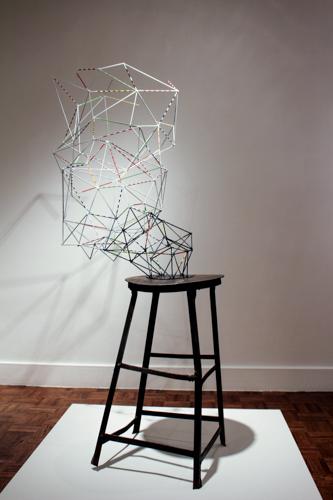[portfolio_slideshow]
Whitman students may notice a dissonance between the urban, intellectual culture of the campus and its rural, distant surroundings. Professors, local artists and even artists from around the country have all gathered to address this dissonance in the Sheehan Gallery’s new “POST-RURAL” exhibition.
The exhibition first opened on Saturday, Sept. 13. Originally a show curated by staff at the University of Montana, the exhibition now features additional work by Whitman faculty and local artists, in addition to a mixture of new and old work from the original contributors.
The term “Post-Rural” originated 14 years ago when University of Montana Professor and original curator Matt Hamon was mocking the concept of postmodernism with his friends. Realizing that they themselves were “transplants” between the modern city and the rural country, the term became a way to examine the relationship between the two spaces and explore the way in which people interact with landscape.
Once he had become a professor, Hamon used the term again to describe some of his own art, but he noticed that the concept seemed to articulate themes many faculty were exploring in their work, so he assembled an exhibition in 2012.
This most recent incarnation of the exhibition was pushed by previous University of Montana professor and current Whitman Assistant Professor of Art Nicole Pietrantoni, who was able to contact some of her old colleagues at the University of Montana as well as Walla Walla-based artists, all working within the same theme of exploring the Post-Rural.
“[We] were grappling with what it means to live in a rural space and to make art about it, especially when we ourselves are transplants,” said Pietrantoni. “We are from urban centers or we grew up in cities and [then we lived] in Montana, which is this sort of romanticized place of The West.”
The core of the exhibition is a dissection of landscape that is becoming an increasingly blurry mix of urban and rural. Areas that used to be rural are being consumed by urban culture, and people moving into the city from the country are bringing their rural culture with them.
While this was a fitting theme for the exhibition’s original home in Montana, Director of Sheehan Gallery Daniel Forbes believes that many of the same concerns affect the people of Walla Walla.
“I think that every place people live, they are very affected by the landscape and that’s one of the things that people in Walla Walla talk so much about is the landscape that surrounds us,” said Forbes.
The material itself is very eclectic, despite this unifying theme of landscape. Abstract sculptures, post cards, distorted photographs, modified statues and even computer desktop screenshots all represent the theme of the Post-Rural.
“I admit that walking into the show, its hard at first to make sense of it,” said Hamon. “The most consistent references throughout the exhibit are references to landscape.”
While the original showing at the University of Montana explored similar themes, the specific concept of “Post-Rural” was not “intentionally considered,” said Hamon. Most of the artists developed their ideas independently of each other.
With this new exhibition, old contributors are addressing the topic with a finer viewpoint and creating art specifically for the show, and new contributors like Whitman Associate Professor of Art Michelle Acuff and local artist Ian Boyden are adding their own experiences to the mix.
“Our work has changed and developed over the past couple years … [It’s] still related to this theme, but the show is different every time it goes up,” said Pietrantoni.









